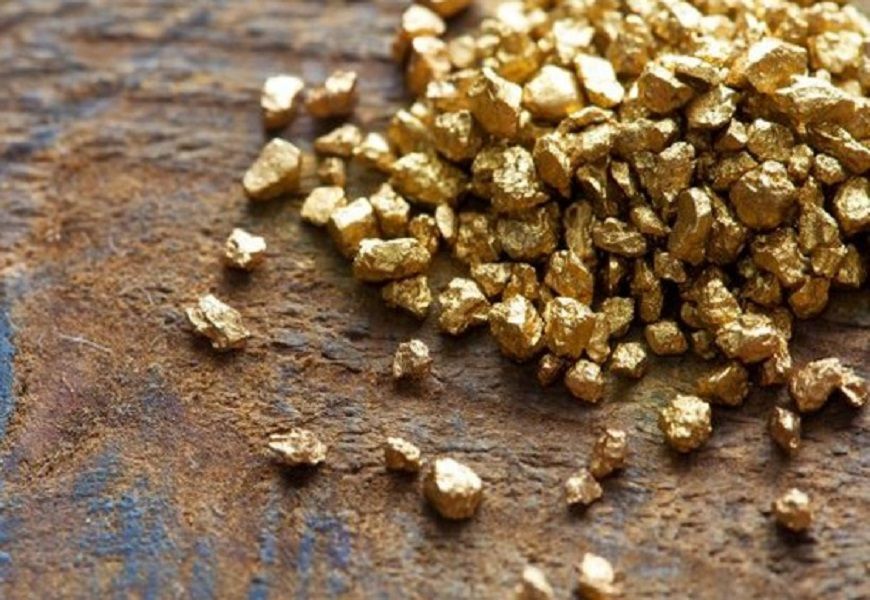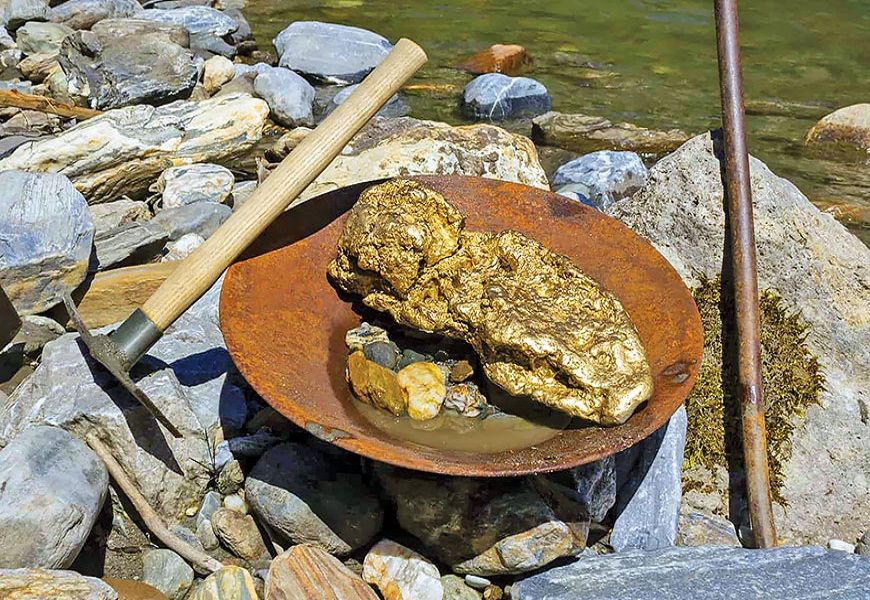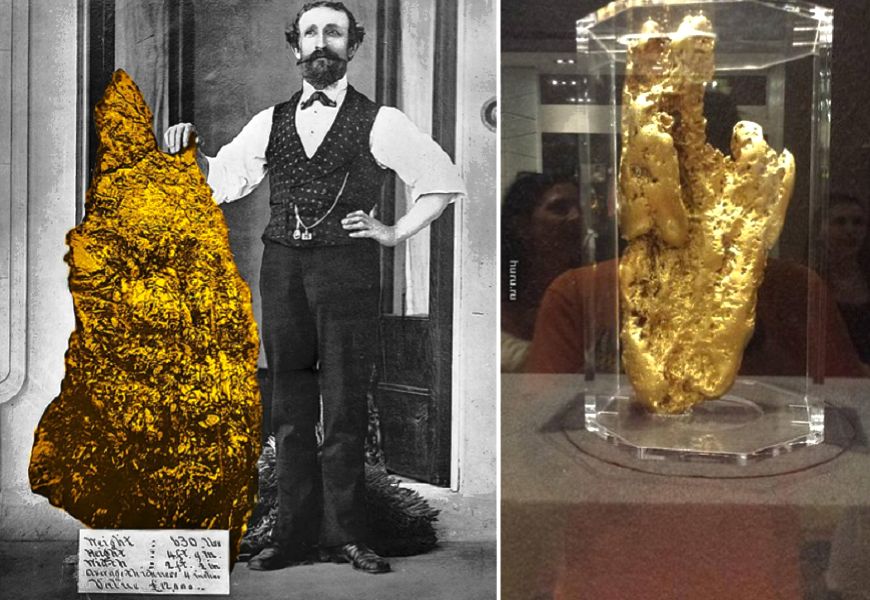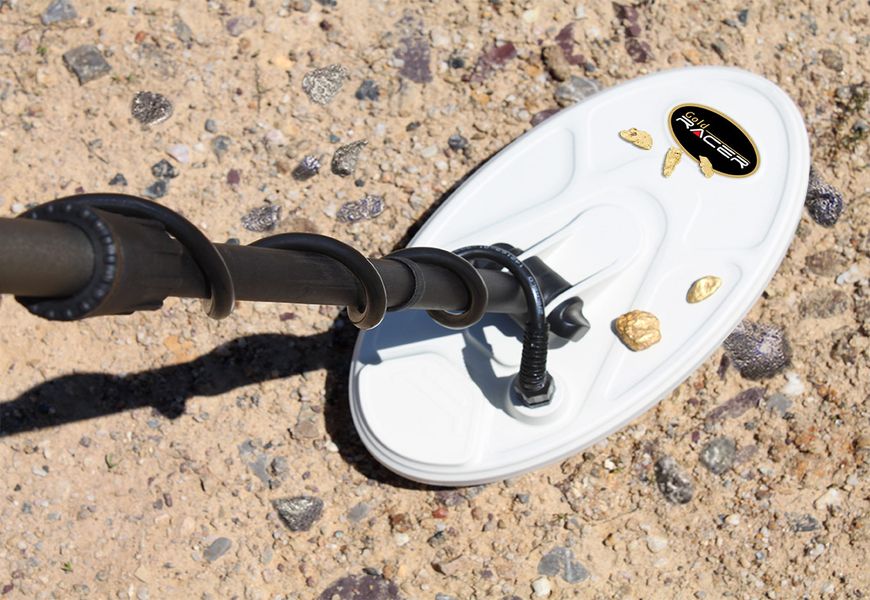ЗOloto has been known to mankind since ancient times. This is evidenced by numerous findings of the heritage of the warlike Scythians and ancient Egyptians. And the famous Golden Man, found on the territory of modern Kazakhstan, shows that about 6 thousand years ago people not only extracted the noble metal, but also had the technology of its processing. Today we will tell you about the largest gold nuggets in the world.
What is a gold nugget: it, composition, what it looks like, structure
Pure high-grade gold is rarely found in nature. Most often, the precious metal is part of ores, minerals, and sometimes present in river sand. Native gold, a piece of precious metal with a minimum of impurities, is a rare and valuable find. It contains impurities of different metals and minerals (up to 20%). The composition of the impurities determines and gold color. Native metal can range in color from white to yellow in all shades.
If the ingot has a lot of copper, it has a pinkish cast.

History of the first gold nugget in Russia. The "gold rush" phenomenon of the mid-19th century
Despite the fact that gold products in Russia began to produce since ancient times, the noble metal was used imported. The fact that the Russian land is rich in gold deposits was known from ancient historical sources. On the places of settlements of the ancient Slavs found finished gold articles. 1745 was the year when native gold was found in the Urals, and two years later the first mine was opened in this place, the mine Pervyachalny.
The 19th century is known for the beginning of the so-called Alaskan gold rush. Dreaming of fabulous wealth, prospectors left their homes and risked their lives.
The gold rush did not spare Russia either. From the beginning of the 19th century, prospectors tried to conquer Siberia and the Far East, the Kuzbass and the Tom.
Why the metal is often confused with pyrite. What geologists say about gold nuggets
With the onset of the gold rush, ships filled with pyrite sailed from America to Europe. This rock was often confused with gold because of its external resemblance. In fact, pyrite is iron oxide, also called the gold of fools or the stone of fools. Gold and pyrite can be distinguished by some characteristics:
- Shape. Pyrite is a crystalline stone with sharp edges; gold has soft, rounded edges.
- Smell. Pyrite contains more than 50% of sulfur, so it has a peculiar rotten smell. The noble metal does not have any odor.
- Size. Pyrite can occur in a variety of sizes. Gold is more often found in placer, less often in small pieces, and even more rarely in large ingots.
- Hardness. This noble metal is very soft and malleable, which is why ligature is used for jewelry or other products. Gold bullion can be easily pierced with a needle and tasted. Pyrite is hard.

Pyrite and gold are similar in color, luster, and density.
Geologists have been studying the similarities between the two rocks:
- A. Betekhtin "The pyrite group. A Course in Mineralogy";
- К. Gurlitt, "Chiropractic Mineralogy;
- A. Smolin "Golden Nuggets of the Urals.
It was only centuries later that pyritic oxide was no longer known as a deceptive stone, and people learned how to make use of its beneficial properties.
Table: characteristics of native gold
What samples are considered to be nuggets? A gold nugget is a solid ingot that must weigh at least 2 grams. There are cases when nuggets weighing almost a penny have been found.
Native gold has the following characteristics:
| Property | Description |
|---|---|
| Color | Yellow is dense, giving off a silvery sheen. It can fade and become brighter, taking on shades of white, pinkish, greenish, reddish. |
| Transparency | Not available |
| Shine | Metal |
| Surface | It can be both smooth and rough. Nicks and notches are present. Often a nugget is found "in a shirt", i.e. the piece is covered with some other rock. |
| Hardness | The noble metal is very soft. On the Mohs scale 2.5-3 |
| Form | There is no need to wait for complete symmetry in the outlines of a piece of gold bullion. It can look like a geometric figure, an animal, a plant, a flat leaf, a feather or a branch. |
| Sample | From 800-950. Nugget gold contains a minimum of impurities. For example, a 585-caliber metal cannot be considered a nugget. |
Hypotheses of gold nugget formation
There are several theories about where gold nuggets come from in the earth.
- Snowball. Gold is a very soft and malleable metal. Gold particles, moving and joining each other, stick together like snowflakes to form a snowball.
- Sediment. Because gold is heavier than water, it settles down. The gold particles layered on top of each other until they form a nugget.
- Gold Stones The gold nuggets of large size can disintegrate when exposed to external influences. Such gold nuggets are very rare to find in nature.
- Scouring. Many ancient gold deposits can be found in river beds or streams. The remnants of gold veins are eroded by currents.
- Top layer. All nuggets are found on the upper layers of ores. It is proven by geologists that these places are bound to have gold deposits.
And these are not the only theories of origin of gold nuggets.

Endogenous origin of gold nuggets. Locations of nuggets today
One theory is that native gold is of endogenous origin. That is, it is formed in the bowels of the earth at a depth of up to several kilometers.
Today nuggets can be found in the following places:
- Gold-bearing veins are up to 10 cm thick. Veins are cracks in the Earth's crust that are filled with ore. The thickness, that is, the thickness of the vein can reach several tens of meters, but also several centimeters. Veins up to 10 cm thick are called veins and are often not of interest to gold prospectors, although the precious metal can be mined there.
- Sites with active metal precipitators. Sulfites, quartz, and coal contribute to gold settling. Therefore, areas with these rocks may well have nuggets.
- Mountain streams, dried up streams. The precious metal is carried into the streams with the current from the mountain slopes. Because gold is heavy, it settles to the bottom.
- Waste deposits. Geologists often prospect on an industrial scale. When the large gold reserves are selected, the prospecting is over. But small particles and nuggets of the precious metal may remain there.
You can learn about the localization of gold deposits from the works and stories of geologists, as well as from the old-timers of the area.

The most famous deposits of gold nuggets found in Russia, unprocessed photos
According to geological maps, the largest gold deposits are concentrated in the territories of the Far East, the Urals, and Siberia. But not everywhere you can find the native precious metal.
- Natalka or Natalka gold-quartz deposit. The name is derived from the name of the daughter of the discoverer-geologist D.Aseev Natalia. It is located in the basin of the Omchak River, 390 km from Magadan.
- Nezhdaninskoye deposit. It is located in Yakutia, in the Aldan River basin. Opened in the 50s of the last century, the mine marked the beginning and the opening of the village of the same name.
- Olimpiadinskoye and Blagodatnoye. The largest fields located on the territory of Krasnoyarsk Territory at a distance of 25 km from each other.
- Darasun gold deposit. Location: Trans-Baikal Territory, Chita Region. Darsun began to be developed as early as 160 years ago.
- The Tash-Targanka River flows on the territory of Miass in Bashkiria. Nowadays gold is not mined here, but literally 200 years ago Tash-Targanka gave so many nuggets that they had to open a gold panning plant in Miass.
- Mokhovoe bog is located in the South Ural region, Chelyabinsk region. Gold is found here by placer. The Bolsheshaldinskaya placer deposit is also located here.
- Sverdlovsk quarries. The Sverdlovsk region is home to the main Ural gold mines deposits. Of these, 75% are placers. At a distance of 50 km from Yekaterinburg are the Kamushki quarries. Since the century before last, prospectors have been searching for precious metal here.
- Kajaran and Sotsk deposits in Armenia. The gold deposits near Sotsk and Kajaran were discovered and developed under the Soviet regime.
Also gold mining is conducted in the Krasnodar region, in the mountains of Adygea, in the Moscow region near the rivers Volgusha, Yakhroma, Iksha, in Novokuznetsk and many other Russian regions.

The riches are near: 10 record-breaking nuggets of the world
Each of the gold nuggets found has a different story. Some of the largest gold nuggets in the world include:
- Holterman Plate. It was found in 1872 in Australia, named after the prospector Bernard Holterman, a German migrant. The slab is also called the Australian giant: it weighed 235 kilograms, of which only 83.2 kilograms of gold. There is still controversy about this nugget: some scientists believe it is simply part of a gold-quartz vein. Unfortunately, the slab was melted down, and all that is left of it is a photo.
- A coveted stranger. Another Australian find dates from 1869, weighing just over 70 kilograms. All that was left at the site of the nugget was a post with the names of the prospectors, John Deason and Richard Watts. In just 5 hours after the discovery, the piece was crushed into small pieces, and it was later shipped to England.
- The Big Triangle. In 1842, a worker at the gold mine, Nikifor Syutkin, found a huge nugget, the weight of which was determined to be 36.2 kilograms. The gold nugget was saved and is still kept by the Diamond Fund. But the fate of the worker who found the triangle was tragic: he went on a drinking binge and died begging for money.
- Oliver Martin. Compared to Nikifor Syutkin, Oliver Martin, whose name was given to the nugget, was fabulously rich. He was not a prospector and found the nugget completely by accident while digging a grave for his friend. The weight of the nugget he found was 36 kg exactly.
- The hand of fate or the hand of Vera. The weight of this nugget is just over 27 kilograms. It was found in Australia in 1980 by the Hiller couple with the help of metal detector. The nugget was bought by the casino, where it is still stored today.
- A horse's head. A piece of gold, which looks like an oblong horse's head, weighs 13 kg 700 g. Was found in the Urals, kept by the Diamond Fund.
- Camel. One more exhibit of the Diamond Fund weighs 9 kg 300 grams. In 1947, it was found in one of the mines of Kolyma by workers.
- Irendyk bear. The nugget, shaped like the body of an animal, weighs 4788 g. It is an exhibit of the National Museum of Bashkiria, the national treasure of the country.
- Hare ears. The nugget really looks like a hare's head with its characteristic shape ears. This is a big stone of the 930th hallmark. So, the metal is natural, practically without any admixtures. The stone weighs more than 3 kg. Found in the South Urals. The stone is kept in the National Museum of Mineral Resources of the Russian Federation.
- Big Hole. This is the name given to the ingot because of its porous structure. But in spite of this, it weighs almost 3 kg. Found in the Urals about 300 years ago.
Of course, there are many more known nuggets. Some of them were melted down for profit. Many nuggets are kept by museums around the world.

Tools to search for native gold. Table: The best metal detectors, parameters and prices
To search for gold on your own, you'll need the bare minimum of prospecting tools. The tools needed to find and work the metal:
- metal detector;
- metal washing tray;
- sieve or sifter;
- shovel;
- pickaxe, chisel, hammer;
- A magnifying glass, a container for the metal found.
Metal detectors sell specialized stores, they can also be bought inexpensively on Avito. It is recommended to choose equipment with the highest power and sensitivity to metal. Of course, high-quality equipment will not cost cheap.
| Metal detector | Features | Price |
|---|---|---|
| XP Metal Detectors Deus | detection depth - 1 meter, battery charge - up to 10 hours. | 62 thousand rubles |
| White's MX7 | The detection coverage is 1 meter 40 cm, waterproof, battery charge time is 20 hours. | 59 thousand rubles |
| Garrett ATX Deepseeker | Detects metals at a depth of 2 meters, works on all types of surfaces, light weight. | 154 thousand rubles |

Official licensing of gold mining activities
According to the Russian Federal Law "On Precious Metals and Precious Stones," gold mining must take place legally. In order to engage in this type of activity, the Rosnedra must issue a license. But this document does not allow to engage in gold mining anywhere, such as Moscow and the Moscow region, St. Petersburg or Krasnodar.
Free miners are allowed to search for gold only in the Magadan region.
How to determine the gold content of a nugget
The richer the gold nugget, the higher its Sample. This can be determined without much expertise:
- Checking authenticity with a needle. Pure gold is soft and easily pierced with sharp objects.
- Testing with iodine. If the gold is real, it will have a dark iodine stain on it.
Of course, the most reliable way to check - special analyzers of samples of precious metals.
What to do with the found nugget
According to Article 129 of the RF Civil Code, found nuggets must be handed over to the tax authority. 20% of the value of the metal must be paid to the finder. Sales of accidentally found nuggets are prohibited.
If you are legally engaged in gold mining, then the nugget can be refined and kept for yourself or deposited in a bank, opening a so-called gold account. It's a great investment. You can also sell it to the same banks and jewelry companies. You can buy gold from you gold mines.
Methods of extracting gold from stone
Nuggets may contain additional mixtures, metallic and mineral. It is possible to get rid of them by refining - purification. Refining methods:
- The dry method involves purifying gold through chlorine gas.
- Chemical or wet - separating gold from impurities by using different chemicals, such as acids.
- Electrolysis. In this case the gold is separated by means of an electric current.
The methods are used both in laboratories and industrial production, rarely in at home.
Video: mining fossils and huge nuggets with their own hands
Prospector's testimonial and recommendation
Gold mining is an interesting and fascinating, but complicated process. It is not only romantic, but there are dangers everywhere. Without proper geological knowledge and outdoor skills it will be difficult to do this business. Therefore, before you go looking for gold, you should talk to geologists, experienced prospectors and read the relevant literature.

